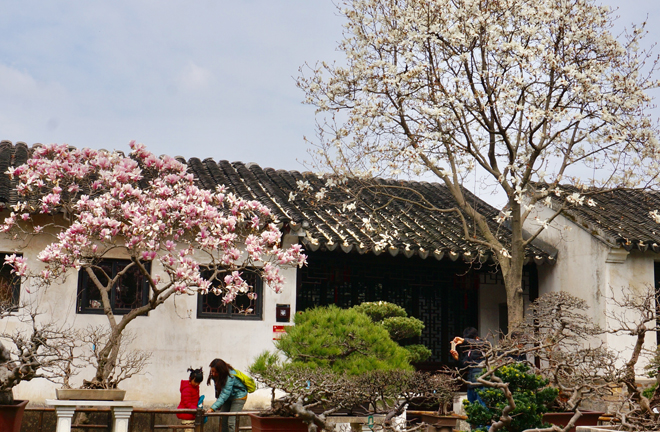Discover aesthetics of classical gardens

The Yulan Hall in the Zhuozheng Garden, built during the Ming Dynasty in Suzhou, Jiangsu Province. The Zhuozheng Garden is one of the four most famous gardens in China. (SUI JINGJING/CSST)
In traditional Chinese culture, classical Chinese gardens integrate various forms of art, such as architecture, literature, philosophy, drama, calligraphy and sculpture. They represent a comprehensive reflection of aesthetics. They also embody the intelligence and creativity of ancient Chinese, demonstrating Chinese classical philosophy and religious beliefs.
In these gardens, natural elements, such as mountains, water and plants are represented in a microcosm of the way they are in nature. The goal of classical Chinese aesthetics is to represent nature.
Classical Chinese gardens developed over a long time and gained sophisticated cultural connotations as their aesthetics changed. Cao Lindi, a professor from the School of Humanities at Soochow University, said classical Chinese gardens evolved from displays of magnificence to focus on more delicate aspects. In the Qin and Han dynasties, the gardens aimed to imitate the grandeur of heaven and earth. In the Wei and Jin dynasties, most of the gardens favored mountain forest villas, reflecting the rough aspects of nature. After the Song Dynasty, the locations of the gardens moved gradually from forests to the outskirts of populated areas and towns.
The construction and growing methods used for the gardens grew increasingly artificial. In the Qin and Han dynasties, the gardens were embellished with natural elements. From the Six Dynasties to the Tang Dynasty, the construction of the gardens depended on both nature and the aesthetic views of architects. The Song Dynasty gardens integrated poetic and pictorial elements, mixing realism with abstract creations. The Ming and early Qing gardens emphasized the creation of artistic concept. Then, during the mid- and late Qing Dynasty, the construction of gardens became stylized: the architecture was enclosed, natural elements were separated and the emphasis on imitating nature was weakened.
Wang Zhenfu, a professor of Chinese language and literature from Fudan University, said classical Chinese gardens have undergone a series of historical changes. In the Shang and Zhou dynasties, most gardens were the royal courts that designed in a way that mimicked the famous “saint” mountains and rivers. Private gardens owned by officials and literati appeared during the Han Dynasty. In the Wei and Jin dynasties, temple gardens emerged. The Tang Dynasty witnessed the rise of rudimentary “garden towns” while literati and imperial style gardens sprang up in the Ming and Qing dynasties.
Classical Chinese gardens are designed around the concepts of external adequacy and internal harmony. That is, gardens should have balanced space to house the beauty of natural scenery and aid in cultivating one’s heart. In other words, the material and spiritual spaces are equally important. Cao said that Chinese used poetry and literature to build gardens and create civilized “poetic dwellings.” The layout of the garden reflected the beauty of Chinese rituals and musical culture. The royal palaces, temples, government offices and residences are ceremonial buildings representing “obedience to heaven.” They used a balanced and symmetrical layout to show solemnity. The scenic gardens of private landscape gardens and imperial gardens contain architecture of lively and colorful styles, with rooms hidden among flowers and pavilions amid waters.
Although classical Chinese gardens were often artificial, they embodied the aesthetic concept of admiring nature. Liao Guowei, a professor from the School of Humanities at Guangxi Normal University, said the gardens emphasized construction methods that hide the fact they were created by people. They endeavor to represent harmony between human work and natural landscapes by introducing natural things into man-made gardens. Thus, almost every garden has a lake or pool of water, reflecting of the sun, the moon, mountains and rivers on the water surface.
As for future methods to study garden aesthetics, Wang pointed out that research on how the classical garden arts are applied to modern parks, urban and rural living spaces. There are practical examples to study, such as the Xiangshan School building in Zhejiang province, which infused these garden concepts into a built environment.
When Western landscape theory swept through the vast lands of China, traditional Chinese gardens were threated with the loss of their discourse power. Cao said that although various new gardens made in traditional styles have appeared one after another, most of them consist of relocated symbols, or are clones of classical gardens that lack the cultural and poetic connotations. Only by inheriting the essence of classical garden culture and art, and drawing upon useful lessons drawn from cultural preservation in other countries, can the creation of new gardens avoid being self-defeating. Only in this way can they become self-reliant, deeply rooted in tradition, and prosperous.
(edited by SUI JINGJING)

 PRINT
PRINT CLOSE
CLOSE